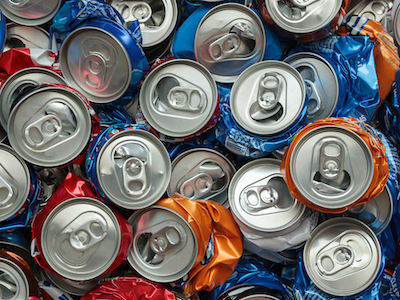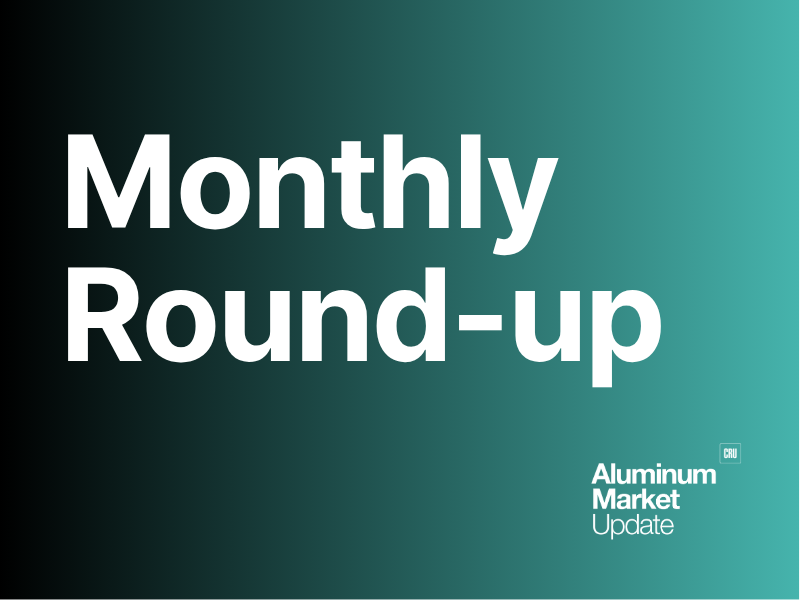Growth Markets

May 29, 2025
UBC scrap spreads: A market caught between a thaw and a simmer
Written by Nicholas Bell
After a rough start to the year, it would seem the floodgates of used beverage can (UBC) supply are reopening based on recent buying spreads.
UBC buying spreads – the price mills pay for baled cans as a percentage of the Midwest transaction price of aluminum – tightened drastically throughout the first quarter, but recently widened again ahead of the busy season for can consumption.
Buying spreads over the last week hovered closer to the mid-to-upper 60% range, a steep drop from the low-to-mid 80% levels that spot buyers were forced to pay earlier in the year.
At the start of 2025, processers were running lean on inventory. By March, tight supply collided with a sharp uptick in the Midwest transaction price.
The first quarter of the year saw a unique market tug-of-war. While some major mills stepped back from the spot market, despite relatively tight supply, larger scrap dealers moved to secure volumes on speculation or intermediate-term minimum volume commitments.
March brought a flurry of tariff impositions, including on finished aluminum products (notably excluding scrap). This sent the Midwest premium sharply higher as the U.S. faced a domestic primary aluminum supply deficit. Simultaneously, the cash settlement on the London Metal Exchange (LME) hit its highest monthly average since May 2022.
Softer summers
Summer ushers in a spike in beverage consumption. As cookouts, beach trips, and outdoor concerts kick off, U.S. beverage can production is expected to rise to 118-119bn cans in 2025, up from 114-115bn in 2024, according to CRU data.
But that demand comes alongside a surge in scrap generation, which partially offsets an inflationary price environment as lower-cost feedstock makes its way into melt mixes in greater quantities.
Even though UBC accounts for just one-third of the can body stock melt mixes, summer oversupply is still a real possibility. Why? Because most mills are covered by contracts and may not need to buy spot UBC, especially during a window when recycling rates are increasing. As spot buying tapers off while inbound material rises, sellers face pressure to lower offers, move volumes, and generate cash. That dynamic puts downward pressure on bids and market indexes adjusts accordingly.
How much scrap is enough?
CRU projects the gap between U.S. aluminum consumption and production in 2025 will be the narrowest since 2018, when domestic supply last outpaced demand.
Can body stock production is expected to land between 1.585-1.62mn metric tons (t). Assuming 30-35% of that output is sourced from UBC scrap, and factoring in 10-15% melt loss, gross UBC demand would fall between roughly 528,000-667,000t.
For context, the U.S. Geological Survey estimated 575,000t of UBC scrap was melted/consumed in 2024, a year with lower production and demand. That suggests the 2025 market could be oversupplied – or at a minimum, well-balanced.
There are caveats, though.
In 2024, the U.S. exported 417,877t of UBC scrap. Meanwhile, imports totaled 206,752t, resulting in a net scrap trade deficit of over 211,000t. That means a sizable portion of scrap supply is leaving the U.S. system entirely, limiting how much domestic demand can soak up surplus material.
The can sheet circuit
It isn’t just UBC scrap the U.S. exports in the beverage market, they’re a net exporter of body can stock as well.
The 118-119bn cans the U.S. is estimated to consume this year seems just in line or slightly over the tonnage of beverage can sheet required to reach that number… until you include Canada and Mexico’s consumption. Suddenly that 1.18-1.19bn number inflated to 148-149bn cans.
The average aluminum can weigh about 13 grams, 75% of which is body stock. Let’s say 3-5% of can production is trimming loss. One metric ton of can body sheet can produce around 97,436-99,487 cans. Using the estimate of 1.62mn t of body sheet production from CRU, that’d equate to about 158-161bn cans if that run rate is met. A nearly 40bn can oversupply when viewed in a vacuum.
Except there’s 15 beverage can production plants across Canada and Mexico owned by the usual players: Ball Corp, Crown Holdings, etc. But there’s zero rolling mills in both countries focused on beverage can sheet production.
While U.S. can sheet production appears to exceed domestic needs at 1.6mn t, enough to produce nearly 160bn cans, those tonnages don’t stay stateside. In 2024, the U.S. exported more than 430,000t of can body stock, with 99% going to Canada and Mexico. That export volume equates to 42-44bn cans’ worth of material, nearly matching the entire U.S. surplus over domestic consumption.
All this means the U.S. isn’t overproducing – it’s functioning as the continent’s rolling mill.
To be fair, on paper, the U.S. imported more than 270,000t of can body stock in 2024 as well – most of it from South Korea. But that’s not a case of foreign dependency. It’s strategic orchestration.
South Korea is home to just two major can body stock rolling mills – and both are owned or partially owned by Novelis. These aren’t third-party suppliers; they’re part of the same vertically integrated supply chain feeding North American demand.
When you combine that with U.S. domestic output and net exports of 166,000t, it’s clear the U.S. isn’t dependent on imported can sheet, especially because that sheet isn’t available to the open market. In other words, it’s not an import option for other producers as these tonnages serve Novelis’ own network.
Stockpiling starts now
UBC inventory building doesn’t happen overnight. Even though Novelis’ Bay Minette and Aluminum Dynamics’ Columbus mills aren’t expected to run anywhere near nameplate capacity in 2026 – both are projected by CRU to produce around 20,000t of can body sheet. Stockpiling efforts are already underway, and those mills will eventually become major UBC buyers.
After those modest first-year estimates for 2026, 2027 is off to the races. The two new mills are expected to produce a combined 244,000t of can body stock, requiring as much as 100,000t (81,000-105,000t to be exact) of UBC scrap using the same assumption about UBC content and melt loss.
That kind of dynamic won’t just tighten regional scrap markets – it has the potential to structurally reshape supply chains.
And with 2025 nearly halfway through, that shift is a lot closer than it seems.
Conclusion
After a winter that froze supply and a spring that inflated prices, the UBC scrap market is heading into the peak season with wider margins and better inventory levels. It should shape up to be more margin friendly. Spot spreads have widened just as demand is about to ramp up, giving mills breathing room for now.
But this reprieve exists in a narrow window. Let’s take a look at where the numbers are pointing.
UBC math for 2025
Let’s take some assumptions
- 118-119bn cans of consumption in 2025 (CRU)
- 1.585-1.62mn t of can sheet production (CRU)
- 13 grams per can (Can Manufacturers Institute)
- 45.2% recycling rate in 2024 (Aluminum Association)
- 71% reclamation rate in 2024 (Aluminum Association)
2024 UBC scrap trade
- Imports: 206,742t
- Exports: 417,877t
From that, we estimate of about 705,500t of UBC scrap could be recycled this year. Backing out a 10-15% melt loss, that equates to roughly 600,000-635,000t of usable material in a melt mix – almost exactly what mills will need to meet the consumption-based production targets from earlier.
So while spreads in the 66-67% range offer relief from the 82-83% squeeze seen earlier this year, they’re resting on a delicate equilibrium. The system is working for now, but with inventories turning faster and future demand loading up, the window for comfort is narrowing even as margins expand.







